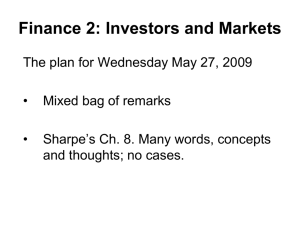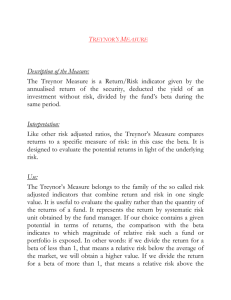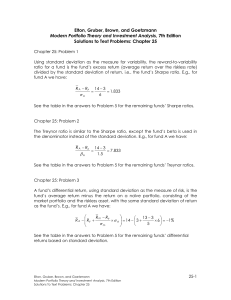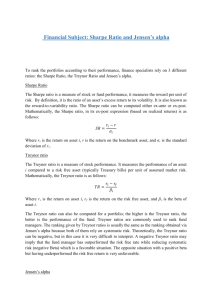Journal Of Financial And Strategic Decisions THE JANUARY SIZE EFFECT REVISITED:
advertisement
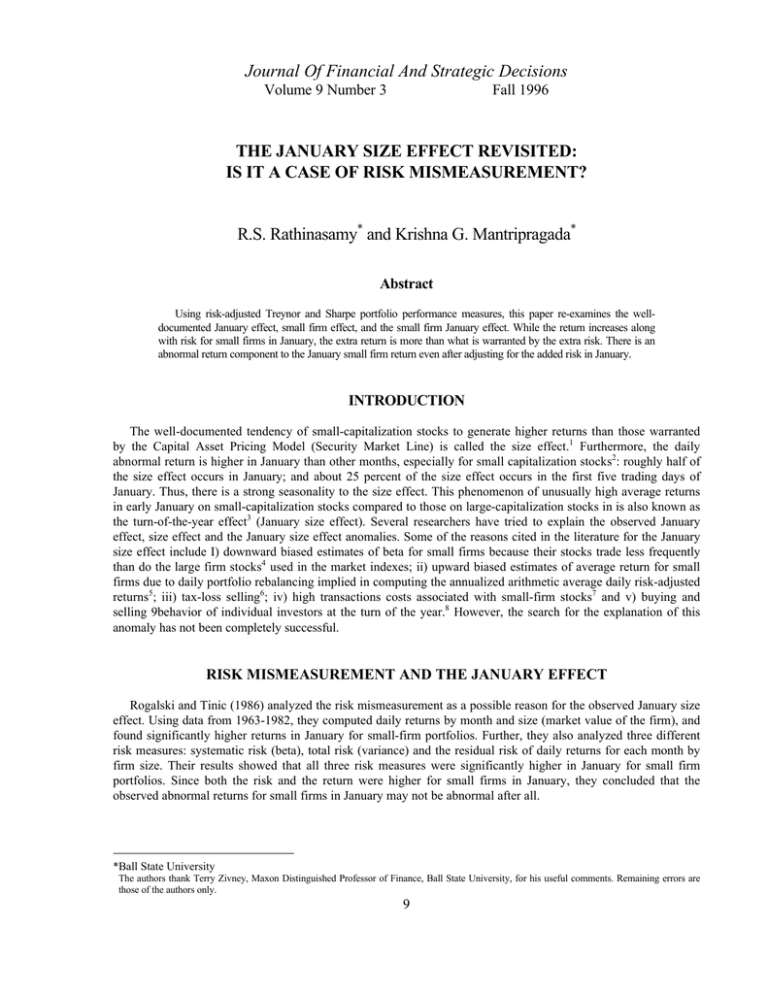
Journal Of Financial And Strategic Decisions Volume 9 Number 3 Fall 1996 THE JANUARY SIZE EFFECT REVISITED: IS IT A CASE OF RISK MISMEASUREMENT? R.S. Rathinasamy* and Krishna G. Mantripragada* Abstract Using risk-adjusted Treynor and Sharpe portfolio performance measures, this paper re-examines the welldocumented January effect, small firm effect, and the small firm January effect. While the return increases along with risk for small firms in January, the extra return is more than what is warranted by the extra risk. There is an abnormal return component to the January small firm return even after adjusting for the added risk in January. INTRODUCTION The well-documented tendency of small-capitalization stocks to generate higher returns than those warranted by the Capital Asset Pricing Model (Security Market Line) is called the size effect.1 Furthermore, the daily abnormal return is higher in January than other months, especially for small capitalization stocks2: roughly half of the size effect occurs in January; and about 25 percent of the size effect occurs in the first five trading days of January. Thus, there is a strong seasonality to the size effect. This phenomenon of unusually high average returns in early January on small-capitalization stocks compared to those on large-capitalization stocks in is also known as the turn-of-the-year effect3 (January size effect). Several researchers have tried to explain the observed January effect, size effect and the January size effect anomalies. Some of the reasons cited in the literature for the January size effect include I) downward biased estimates of beta for small firms because their stocks trade less frequently than do the large firm stocks4 used in the market indexes; ii) upward biased estimates of average return for small firms due to daily portfolio rebalancing implied in computing the annualized arithmetic average daily risk-adjusted returns5; iii) tax-loss selling6; iv) high transactions costs associated with small-firm stocks7 and v) buying and selling 9behavior of individual investors at the turn of the year.8 However, the search for the explanation of this anomaly has not been completely successful. RISK MISMEASUREMENT AND THE JANUARY EFFECT Rogalski and Tinic (1986) analyzed the risk mismeasurement as a possible reason for the observed January size effect. Using data from 1963-1982, they computed daily returns by month and size (market value of the firm), and found significantly higher returns in January for small-firm portfolios. Further, they also analyzed three different risk measures: systematic risk (beta), total risk (variance) and the residual risk of daily returns for each month by firm size. Their results showed that all three risk measures were significantly higher in January for small firm portfolios. Since both the risk and the return were higher for small firms in January, they concluded that the observed abnormal returns for small firms in January may not be abnormal after all. *Ball State University The authors thank Terry Zivney, Maxon Distinguished Professor of Finance, Ball State University, for his useful comments. Remaining errors are those of the authors only. 9 10 Journal Of Financial And Strategic Decisions RETURN FOR SMALL FIRMS IN JANUARY IN RELATION TO RISK The study of the January size effect by Rogalski and Tinic (1986) shows that both return and risk are higher for small stock portfolios particularly in January. However, they did not closely examine the return for small stocks in January in relation to their risk. If the return in January is just equal to the rate required by the increased January risk, then the January size effect is merely a reflection of higher risk and not anomalous. On the other hand, if the return in January is significantly higher even after adjusting for the higher risk in the month, the January size effect remains unexplained. PORTFOLIO PERFORMANCE MEASURES AND THE JANUARY SIZE EFFECT The relation between return and risk and the question of whether the January return for small stocks is higher even after adjusting for the extra risk may be tested by computing risk-adjusted portfolio performance measures. Two such well-known measures are: the Treynor measure and the Sharpe measure for the portfolio returns. We compute these measures using the results from Rogalski and Tinic (1986) study. We find that there is a January size effect for the 1963-1982 period, even after adjusting for risk. DATA AND METHODOLOGY The data used in this study are the summary statistics from Rogalski and Tinic (1986, Tables I-III). Using data from the Center for Research in Security Prices for the 1963-1982 period, they have computed portfolio returns, betas and variances for 20 different portfolios ranked by market size. We used the: i) firm portfolio daily mean returns for 20 different size portfolios ranked by size (with portfolio 1 being the smallest) for each month (from their Table I) ii) average variances of daily percentage returns for each month (from their Table II) and iii) betas of firm-size portfolios by month (from their Table III). In addition, using data from Citibase9, we computed the average daily rate for 90-day T-bill for each month in the 1963-1982 period. This average risk-free rate by month was used in computing the performance measures. Specifically, we computed the following measures of performance10 for each of the twelve months: Equation 1 Treynor Measure (Tp) = (Rp - Rf) / βp Equation 2 Sharpe Measure (Sp) = (Rp - Rf) / σp where: Rp Rf βp σp = Average of the common stock daily portfolio return for given month = Average 90-day daily T-bill rate for a given month = Average beta of the portfolio for a given month = Average standard deviation of the portfolio for a given month Treynor measure looks at excess return per unit of the systematic (non-diversifiable) risk; Sharpe measure analyzes excess return in relation to total variability. Dividing the excess returns by the beta or standard deviation of returns puts the returns on a common platform with respect to risk. Then, using t-statistics, we compare the differences in true risk-adjusted measures in January to all other months, both individually and as a group. It is also possible to test separately for the January effect, size effect and the January size effect, using a dummy variable regression approach. The two dummy variable regressions are: 11 The January Size Effect Revisited: Is It A Case Of Risk Mismeasurement? Equation 3 Tp = D1 + D2 + D1 ∗ D2 Equation 4 Sp = D1 + D2 + D1 ∗ D2 where: D1 = A dummy variable with a value of 1 for January, 0 otherwise. D2 = A dummy variable with a value of 1 for firm size portfolio between 1 and 5 (small firms); 0 for firm size 6 through 20. Finding a significant coefficient for D1 will imply the existence of the January effect, while a significant positive value for D2 will provide support for the existence of the size effect, and finding a significant positive coefficient for the interaction term, D1∗D2, will indicate the existence of the January size effect. RESULTS AND DISCUSSION The results of the analysis comparing the Treynor performance measure in January to other months are presented in Table 1. The Treynor measure for January is 0.2589, the highest value observed; the difference from each of the other months and as a group is significant at the 1 percent level. Therefore, the results based on comparing the returns in different months after adjusting for the systematic risk clearly show that the risk-adjusted measure of performance is indeed higher in January. TABLE 1 A Month-By-Month Comparison Of Mean Daily Portfolio Returns Using Treynor Measure Difference From January Performance Measure t-Statistics For The Difference 0.25890 -0.01439 0.02591 0.03792 -0.07186 -0.05479 0.27329 0.23299 0.22098 0.33076 0.31369 6.54*** 5.87*** 5.25*** 8.41*** 7.98*** 20 20 -0.00778 -0.00473 0.26668 0.26363 6.74*** 6.73*** 20 20 20 20 0.01174 -0.04060 0.03142 0.02200 0.24716 0.29950 0.22748 0.23690 6.16*** 7.63*** 5.81*** 6.07*** 220 -0.00592 0.26482 6.78*** Number Of Observations Sharpe Measure January February March April May June 20 20 20 20 20 20 July August September October November December February–December Month *** Significant at 1 percent level 12 Journal Of Financial And Strategic Decisions The results of comparing the Sharpe performance measure in January to other months are presented in Table 2. This measure evaluates the performance after adjusting for the total risk of the portfolio. The Sharpe measure for January is 0.26984 and its difference with each of the remaining 11 months separately and as a group, is significant at the 1 percent level as well. TABLE 2 A Month-By-Month Comparison Of Mean Daily Portfolio Returns Using Sharpe Measure Difference From January Performance Measure t-Statistics For The Difference 0.26984 -0.02393 0.02920 0.02899 -0.07652 0.29287 0.23974 0.23995 0.34546 7.11*** 6.31*** 6.38*** 9.15*** 20 20 20 20 20 -0.07145 0.01111 -0.00654 0.01095 -0.04396 0.34039 0.28005 0.27548 0.25799 0.31290 8.99*** 7.35*** 7.34*** 6.71*** 8.31*** 20 20 220 0.03335 0.02520 -0.00962 0.23559 0.24374 0.27856 6.29*** 6.52*** 7.45*** Number Of Observations Sharpe Measure January February March April May 20 20 20 20 20 June July August September October Month November December February–December *** Significant at 1 percent level The results from both the Treynor and Sharpe measures show that the returns in January are indeed higher even after adjusting for risk, providing support for the January effect. TEST OF THE JANUARY EFFECT, SMALL FIRM EFFECT AND THE SMALL FIRM JANUARY EFFECT The results of the dummy variable regression on Treynor and Sharpe measures are presented in Table 3. Equations (3) and (4) enable us to test for the January effect, the small firm effect and the January small firm effect using Treynor and Sharpe measures respectively. The results of equation (3) are presented under Treynor in Table 3 and support the following inferences: (I) the coefficient for January is 0.19490, significant at the 1 percent level and therefore, the Treynor measure in January is significantly higher than the non-January months by an average of 0.195 percent. The results show that after adjusting for the systematic risk, there is a January effect. (ii) The size coefficient of 0.03419 is also significant at 1 percent level, indicating that the systematic-risk-adjusted return for small-firm portfolios is indeed higher than that of the large firm portfolios. (iii) The interaction term January∗size is 0.27968, once again significant at the 1 percent level. The statistical significance of the interaction term indicates the presence a small firm January effect, even after adjusting for the systematic risk of the portfolios. The results of regression based on equation (4) are presented under Sharpe in Table 3. The analysis is similar to the one for the Treynor measure presented above, except that this equation uses Sharpe performance measure. The 13 The January Size Effect Revisited: Is It A Case Of Risk Mismeasurement? coefficient for January is 0.21658, significant at the 1 percent level, consistent with a January effect, even after adjusting the return for the total risk. The coefficient for the small firms is 0.04037, significant at the 1 percent level. Finally, the interaction term, January∗size, which tests for the small firm January effect is also significant at the 1 percent level, providing strong support for the existence of the small firm January effect even-after adjusting for the total risk. The results of the dummy variable regressions clearly confirm the existence of the January effect, small firm effect and the small firm January effect for the common stocks during the study period. TABLE 3 Dummy Variable Regression Results On Treynor And Sharpe Measures Measure Variable Coefficient t-Statistics January (D1) 0.19490 12.89*** Size (D2) 0.03419 3.92*** January∗Size (D1∗D2) 0.27968 9.25*** January (D1) 0.21658 14.25*** Size (D2) 0.04037 4.60*** January∗Size (D1∗D2) 0.25154 8.27*** Treynor (240) Equation (3) Sharpe (240) Equation (4) Adjusted R-squared 0.69 0.70 *** Significant at 1 percent level Figures in parentheses are number of observations. SUMMARY AND CONCLUSIONS In this paper, we adjusted returns of market-capitalization based portfolios for the 1963-1982 period for systematic risk and total risk, by computing the Treynor and Sharpe measures. Then we tested the differences in these January performance measures with each of the other eleven months separately and as a group using tstatistics. Furthermore, we tested the January effect, small firm effect, and the small firm January effect using dummy variable regressions on both the Treynor and Sharpe measures. Since the difference in January with respect to all the other months was significantly positive both for the Treynor and Sharpe performance measures, one may conclude that there is a January effect even after adjusting for risk. The results also show that there is indeed a January effect, small firm effect and a small firm January effect. Small firms in January do generate abnormal returns. Both risk and return are higher for small firms in January, but the return is much higher than what is warranted by the extra risk involved. Therefore, the analysis of Rogalski and Tinic’s (1986) data suggests that, contrary to their interpretation, higher risk during January does not completely explain the small firm anomaly. ENDNOTES 1. Banz (1981) first documented the size effect by showing that small firms had higher risk-adjusted returns than large firms for the 1936-1977 period. 2. For example, see Keim (1983). 14 Journal Of Financial And Strategic Decisions 3. See Ritter (1983). 4. This reasoning has been investigated by Roll (1981) and Reinganum (1981). 5. See Roll (1983) and Blume and Stambaugh (1983). 6. Tax-loss selling as a possible cause for the small firm effect has been researched by Reinganum (1983). 7. For this explanation of the small firm effect, see H. Stoll and R. Whaley (1983). 8. Buying and selling behavior as a possible cause for the turn-of-the-year was investigated by Jay R. Ritter (1983). 9. Citibase is a CitiCorp Economic Data Base from CitiCorp Data Base Services, New York, N. Y., 1992. 10. For information on computing the portfolio performance measures, see Zvie Bodie, Alex Kane, and Alan J. Marcus (1993). REFERENCES [1] Banz, R.W., “The Relationship Between Return and Market Value of Common Stocks,” Journal of Financial Economics, Vol. 9, 1981, pp. 3-18. [2] Bodie, Zvie, Alex Kane, and Alan J. Marcus, Investments, Richard D. Irwin Inc., 1993. [3] Blume, Marshall E. and Robert F. Stambaugh, “Biases In Computed Returns: An Application To The Size Effect,” Journal of Financial Economics, Vol. 12, 1983, pp. 387-404. [4] Citibase, CitiCorp Data Base Services, New York, N. Y., 1992. [5] Keim, Donald B., “Size Related Anomalies and Stock Return Seasonality: Further Empirical Evidence,” Journal of Financial Economics, Vol. 12, 1983, pp. 13-32. [6] Reinganum, Marc R., “The Anomalous Stock Market Behavior of Small Firms in January: Empirical Tests for Tax-Loss Selling Effect,” Journal of Financial Economics, Vol. 12, 1983, pp. 89-104. [7] Reinganum, Marc R., “Misspecification of Capital Asset Pricing: Empirical Anomalies Based on Earnings Yields and Market Values,” Journal of Financial Economics, Vol. 9, 1981, pp. 19-46. [8] Ritter, Jay R., “The Buying and Selling Behavior of Individual Investors at the Turn of the Year,” Journal of Finance, July 1983, pp. 701-717. [9] Rogalski, Richard J., and Seha M. Tinic, “The January Size Effect: Anomaly or Risk Mismeasurement?” Financial Analysts Journal, Vol. 42, No. 6, November-December 1986, pp. 63-70. [10] Roll, Richard, “A Possible Explanation of the Small Firm Effect,” Journal of Finance, Vol. 36, 1981, pp. 879-888. [11] Roll, Richard, “On Computing Mean Returns and the Small Firm Premium”, Journal of Financial Economics, Vol. 12, 1983, pp. 371-386. [12] Stoll, H., and R. Whaley, “Transaction Costs and the Small Firm Effect,” Journal of Financial Economics, Vol. 12, 1983, pp. 57-79.
